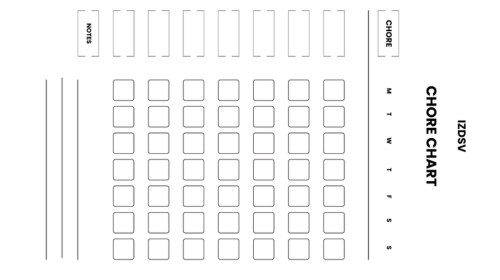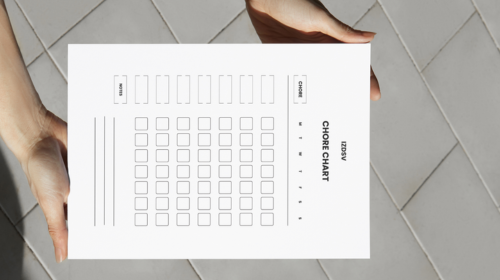What is a Chore Chart and Why is it Important?
A chore chart is a visual tool used to organize and track household tasks assigned to family members. It’s important because it helps distribute work fairly and ensures essential tasks don’t get overlooked.
- Provides a clear visual representation of who is responsible for which tasks
- Creates accountability for household responsibilities
- Prevents arguments about whose turn it is to complete tasks
- It makes household management more efficient and organized
- Helps establish routine and structure in daily life
- Ensures all necessary household tasks get completed regularly
Understanding the Basics of a Chore Chart
A chore chart typically includes task names, assigned individuals, and completion tracking. The most effective charts are simple, visible, and tailored to your family’s specific needs and capabilities.
- Lists specific household tasks that need regular completion
- Associates each task with a specific person or rotation schedule
- Includes method for tracking completion (checkmarks, stickers, etc.)
- Can be digital or physical (whiteboard, printed paper, app-based)
- Should be placed in a central, visible location
- Can include frequency indicators (daily, weekly, monthly tasks)
- Often uses color-coding or symbols for easy visual recognition
Benefits of Using a Family Chore Chart
Family chore charts promote teamwork and create a sense of shared responsibility for maintaining the home. They reduce the mental load on parents who would otherwise need to constantly remind family members about their responsibilities.
- Distributes workload fairly among family members
- Reduces nagging and reminders from parents
- Creates a sense of teamwork and shared responsibility
- Provides visual satisfaction when tasks are completed
- It helps identify if certain family members are overloaded
- Teaches time management skills
- Can reduce family tension around household duties
- It gives everyone awareness of what others contribute
How Chore Charts Help Teach Responsibility
Chore charts give children concrete ways to contribute to family life while developing important life skills. They create a framework where children can experience the satisfaction of completing tasks independently.
- Teaches children that actions have consequences (both positive and negative)
- Helps children understand their role in family functioning
- Builds self-confidence through task completion
- Develops work ethic and time management skills
- Creates understanding of cause and effect (messy room = more work later)
- Prepares children for adult responsibilities
- Instills habits of consistency and follow-through
- Provides age-appropriate challenges that grow with the child
How to Create a Chore Chart Template
Creating a chore chart template is a straightforward process that can be tailored to your family’s specific needs. The key is finding a format that works for everyone involved and is easy to maintain consistently.
- Start with a simple grid or table format with days of the week across the top
- List family members’ names down the left side
- Include space for task descriptions and completion tracking
- Consider using different colors for different types of chores
- Add a reward system or point tracking if desired
- Keep the design clean and uncluttered for easy reading
- Test your template for a week and make adjustments as needed
- Include a legend if using symbols or color-coding
Choosing the Right Printable Chore Chart Template
Selecting an appropriate printable chore chart depends on your family’s age range and organizational style. The best template balances visual appeal with practical functionality.
- Consider age-appropriateness (picture-based for younger children, text for older)
- Evaluate how much detail and structure your family needs
- Look for templates that include space for rewards or incentives if using them
- Check if the template allows for daily, weekly, and monthly tasks
- Consider magnetic or dry-erase options for reusability
- Ensure the template size works for your display location
- Look for templates with clear visual distinction between completed/uncompleted tasks
- Choose designs that match your home’s aesthetic if it will be displayed prominently
Customizing Your Chore Chart for Kids
Personalizing chore charts for children increases engagement and ownership of responsibilities. Making adjustments based on age and interests helps ensure the system will be embraced.
- Include your child’s name and possibly their photo
- Use their favorite colors or characters to increase interest
- Add picture icons for young children who can’t read yet
- Adjust task difficulty based on age and abilities
- Create a personalized reward system that motivates each child
- Allow children to help design their charts when possible
- Include a mix of daily routine items and weekly responsibilities
- Consider adding a “challenge chore” section for bonus rewards
Using Canva to Design a Chore Chart
Canva offers an accessible platform for creating customized, visually appealing chore charts. The intuitive design tools make it easy even for those with minimal design experience.
- Start with one of Canva’s premade chore chart templates
- Customize colors and fonts to match family preferences
- Add your own photos or choose from Canva’s image library
- Use the grid tool to create organized rows and columns
- Incorporate icons or stickers for visual interest
- Download as PDF for printing or as an image for digital use
- Save your design to make future modifications easier
- Use Canva’s resize tool to create different versions (refrigerator size, binder size, etc.)
What Should Be Included in a Weekly Chore Schedule?
A weekly chore schedule should include all essential housework distributed across days to ensure manageable workloads. It requires balancing routine daily tasks with deeper cleaning and maintenance activities that can be done less frequently.
- Kitchen duties (dishes, countertop cleaning, floor sweeping)
- Bathroom cleaning tasks (toilet, shower, sink, mirrors)
- Laundry responsibilities (washing, folding, putting away)
- Floor care (vacuuming, mopping, spot cleaning)
- Dusting and surface cleaning throughout the house
- Trash and recycling management
- Pet care tasks if applicable
- General tidying and decluttering sessions
- Meal planning and grocery shopping
- Outdoor maintenance like lawn care or snow removal (seasonal)
Daily Chores vs. Weekly Chores: What to Assign
Daily chores typically address immediate living needs while weekly chores focus on deeper cleaning and maintenance tasks. Striking the right balance prevents household members from feeling overwhelmed by daily responsibilities.
- Daily chores: dishes, making beds, quick kitchen wipe-downs, picking up toys/clutter
- Daily chores: pet feeding/walking, taking out trash as needed, basic tidying
- Weekly chores: vacuuming, mopping, bathroom deep cleaning
- Weekly chores: changing bedsheets, dusting furniture, cleaning appliances
- Weekly chores: grocery shopping, meal prep, laundry (though some families do laundry more frequently)
- Weekly chores: window cleaning, mirror polishing, decluttering surfaces
- Biweekly/Monthly: cleaning inside refrigerator, washing curtains, deep oven cleaning
- Seasonal chores: gutter cleaning, seasonal decoration changes, wardrobe rotation
Age-Appropriate Chores for Kids
Age-appropriate chore assignment helps children develop responsibility while setting them up for success. The complexity and independence level should increase gradually as children grow.
- Ages 2-3: putting toys in bins, placing dirty clothes in hamper
- Ages 4-5: making bed with assistance, setting table, watering plants, sorting laundry
- Ages 6-7: taking out small trash bags, folding simple laundry, helping with meal prep,
- Ages 8-9: loading the dishwasher, vacuuming, cleaning the bathroom sink, making simple snacks, helping feed pets
- Ages 10-12: washing dishes, cleaning bathroom, doing laundry with supervision
- Ages 13-15: preparing simple meals, deep cleaning bedrooms, doing laundry independently
- Ages 16+: grocery shopping assistance, meal planning and cooking, yard work, car maintenance
- All ages: customized responsibilities based on individual capabilities and maturity
How to Make Your Chore Chart Engaging
Creating an engaging chore chart increases participation and consistency from all family members. Visual appeal and reward systems help transform chores from obligations into satisfying accomplishments.
- Use bright colors, stickers, or digital badges to mark completions
- Implement a point system that leads to meaningful rewards
- Add a competitive element for siblings through leaderboards or challenges
- Incorporate technology with apps that send reminders and track progress
- Take photos of properly completed tasks as visual references
- Create themed chore charts based on favorite movies or characters
- Include a “chore of the week” that rotates for variety
- Add a celebration ritual for when all weekly chores are completed (family movie night, special dessert, etc.)
Tips for Implementing a Family Chore Chart
Implementing a family chore chart requires clear communication, consistency, and buy-in from all family members. Starting small and building gradually often leads to the most sustainable success.
- Start with a family meeting to explain the purpose and benefits
- Begin with fewer chores and gradually add more as the system takes hold
- Be consistent with expectations and check-ins
- Display the chart prominently where everyone can see it
- Review and adjust the system regularly based on what’s working
- Celebrate successes and improvements rather than focusing on failures
- Demonstrate proper techniques for unfamiliar chores
- Consider a trial period before making the system permanent
- Be patient as everyone adjusts to new responsibilities
How to Assign Household Chores Effectively
Effective chore assignment balances fairness with individual capabilities and schedules. Taking multiple factors into account creates a system that feels equitable to all family members.
- Consider each person’s age, abilities, and developmental stage
- Factor in school, work, and extracurricular schedules
- Rotate undesirable chores so no one person always has them
- Match chores to interests when possible (gardening for plant lovers, etc.)
- Consider pairing younger children with older family members for teaching opportunities
- Ensure workload is distributed equitably, not necessarily equally
- Take into account the time commitment of different chores
- Allow some choice in chore selection to increase ownership
- Consider physical limitations and accessibility needs
Creating a Reminder System for Chores
An effective reminder system reduces nagging while ensuring chores don’t get forgotten. The right approach varies based on family members’ preferences and technology comfort levels.
- Set consistent times for routine chores to build habits
- Use smartphone alerts or calendar reminders for tech-savvy family members
- Place sticky notes in relevant locations (bathroom mirror for bathroom cleaning day)
- Link chores to existing routines (“after breakfast, load the dishwasher”)
- Use visual timers for younger children
- Create verbal cues or family catchphrases as gentle reminders
- Install a household management app that sends automatic notifications
- Use physical tokens or magnets that move from “to do” to “done” sections
- Implement a buddy system where family members remind each other
Involving Kids in the Family Meeting to Assign Chores
Including children in the chore planning process increases their investment and reduces resistance. The family meeting becomes an opportunity for meaningful contribution and voice.
- Ask for their input on which chores they prefer or dislike
- Let them suggest fair ways to divide responsibilities
- Have them demonstrate chores they already know how to do
- Allow them to propose reasonable consequences for missed chores
- Discuss the “why” behind important household tasks
- Let them design or customize their own chore-tracking system
- Brainstorm rewards or incentives together
- Create space for questions and concerns about assigned tasks
- Acknowledge their contributions to family functioning during the meeting
How to Stay on Top of Household Chores
Staying on top of household chores requires creating sustainable systems and habits that teach your kids and that work with your family’s natural rhythms. Consistency and routine are key factors in maintaining household order without feeling overwhelmed.
- Create a “daily reset” routine where everyone spends 10-15 minutes tidying before bed
- Break larger tasks into smaller, more manageable steps when making a chore chart
- Address messes immediately rather than letting them accumulate
- Implement the “one touch” rule – put items away immediately rather than setting them down
- Keep cleaning supplies accessible in areas where they’re frequently needed
- Do one complete load of laundry (wash, dry, fold, put away) rather than partial loads
- Create dedicated times in your schedule for household maintenance
- Limit the number of active projects to prevent multiple unfinished tasks
- Use the “two-minute rule” – if a task takes less than two minutes, do it immediately
Strategies to Ensure Chores Don’t Get Overlooked
A combination of visual cues, routine checks, and accountability measures helps prevent chores from falling through the cracks. Creating redundant systems ensures important tasks get completed.
- Schedule a weekly family check-in to review completed and missed chores
- Conduct evening “chore checks” before favorite activities like screen time
- Assign a “chore captain” who rotates weekly to ensure completion
- Take before/after photos of spaces to track progress
- Create visual cues like empty laundry baskets or clean counters that signal task completion
- Use “if/then” planning: “If it’s Tuesday, then we clean the bathrooms”
- Group similar chores together for efficiency (all dusting, all floor cleaning)
- Create a “catch-up day” in your schedule for overlooked tasks
- Implement a text or app-based customizable family reminder system
Adjusting Your Chore Chart as Needed
Flexibility and willingness to modify your system ensures long-term success. Regular evaluation helps identify what’s working and what needs adjustment.
- Schedule monthly reviews to assess effectiveness and make changes
- Adjust during major life transitions (new school year, new job, etc.)
- Rotate chores periodically to prevent boredom
- Add seasonal chores as needed (yard work in summer, holiday decorating in winter)
- Consider temporary adjustments during illness or busy periods
- Increase responsibility gradually as children mature
- Be willing to try completely different systems if the current one isn’t working
- Get input from all family members about what’s working/not working
- Watch for signs of burnout or resentment and redistribute accordingly
Encouraging Kids to Complete Each Task
Motivating children to complete chores consistently requires a balance of clear expectations, positive reinforcement, and appropriate consequences. Building intrinsic motivation leads to long-term responsibility.
- Use positive reinforcement rather than punishment-based approaches
- Create clear visual guides showing what needs to be done and how completed tasks should look
- Build in immediate small rewards for task completion
- Connect chores to valued privileges (screen time after chores, etc.)
- Share the “why” behind important tasks to build understanding
- Notice and praise effort and improvement, not just perfect results
- Use chore completion as teaching moments rather than criticism opportunities
- Make it fun with music, timers, or friendly competitions
- Give choices within boundaries (“Would you like to clean your room before or after lunch?”)




